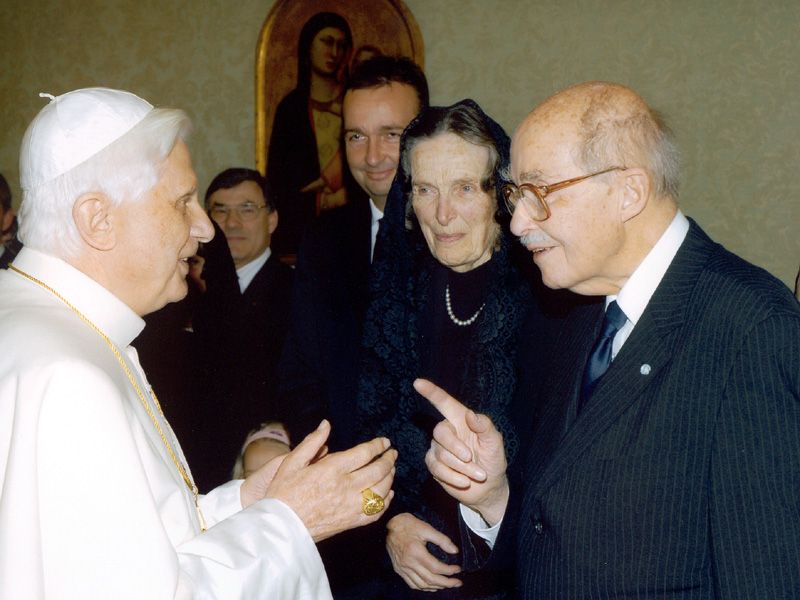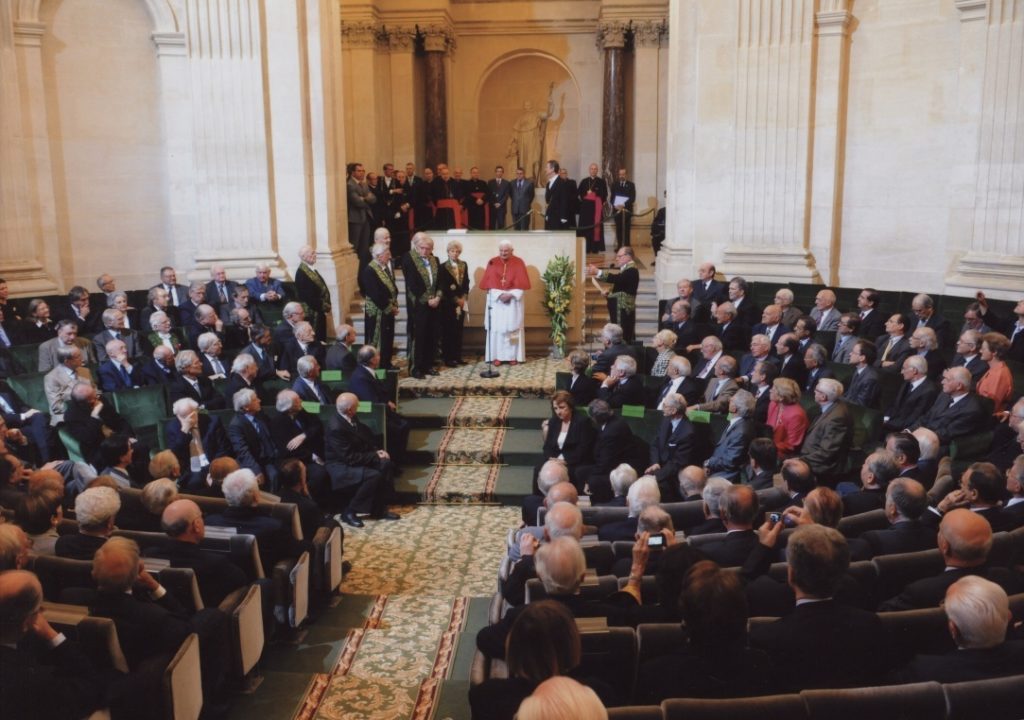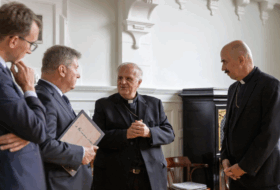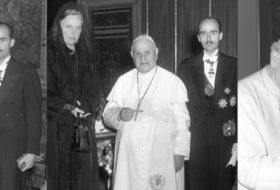The former Crown Prince and Joseph Ratzinger were acquainted in the 1970s. Both played significant roles in Bavaria during this period: the future Pope as Archbishop and Otto von Habsburg as President of the Pan-European Movement and as Member of the European Parliament – both committed to the cause of preserving Christian Europe. They corresponded for many years and met in person on several occasions.
The first letter found in the archives of the Otto von Habsburg Foundation – which are currently being sorted – was sent to the former Crown Prince by Joseph Ratzinger, Archbishop of the Archdiocese of Munich-Freising, in February 1980, in which he briefly congratulated the former Crown Prince on his receipt of the Grand Cross of the Order of St. Gregory the Great from Pope John Paul II a few weeks earlier. Otto von Habsburg wrote in his response letter:
“The sign of papal grace will inspire me to continue to work with all my remaining strength for Christian Europe, which we must achieve if we do not want to let our continent be subjugated. Your Eminence’s [Joseph Ratzinger] great moral authority at a critical time has been a decisive factor in the successes achieved so far.”[1]
The letter also refers to the fact that in 1979, when Otto von Habsburg stood as a candidate for the first European Parliamentary elections for the Bavarian Christian Social Union (CSU), the then Archbishop of Munich-Freising stood up for him against his socialist opponent Helmut Rothemund. Among other things, the left-wing politician criticised Cardinal Joseph Ratzinger’s celebration of Mass before the Pan-European General Assembly held on 12 May 1979 in the Olympic Stadium in Munich. He attributed this event to the masterminding of Otto von Habsburg. Rothemund criticised both the party propaganda aspect of the Mass and the subsequent event and even accused the former heir to the throne of racism. In a letter to the socialist MEP, Joseph Ratzinger defended Otto von Habsburg, stressing that the CSU candidate was working for a united Christian Europe and had saved thousands of Jews from death during World War II – and that the accusations were, therefore, unfounded.[2]
The letters between Otto von Habsburg and the future Pope from 1980 onwards are fragmentary but can be traced through the documents in our collection. The correspondence reveals that the eponym of our Foundation asked Cardinal Ratzinger for his intercession, advice and, above all, his prayers and encouragement on several occasions. Especially after the Archbishop of Munich-Freising became Prefect of the Congregation for the Doctrine of the Faith at the Holy See in 1981. Otto von Habsburg also sent a message to Pope John Paul II through Cardinal Ratzinger. He considered it necessary to inform the leaders of the Catholic Church about research in church history concerning Central Europe and the Balkans.
In 1981, he requested, among other matters, that Cardinal Ratzinger receive Father Klaus Brantzen,[3] who had published a study on the history of the persecution of anti-Hitler Christian priests, especially Catholics. On several occasions, he recommended to the Prefect of the Congregation for the Doctrine of the Faith the works of the Slovenian historian Tamara Griesser-Pecar on church history[4]. In 1992, he asked the Cardinal for help with the plan of the Abbot of the Bavarian Benedictine Abbey of Weltenburg for an association to help Central Europe.[5] Otto approached Joseph Ratzinger on a wide variety of subjects. In 1996, for example, he recommended Max Turnauer, then ambassador of the Sovereign Military Order of Malta in Prague and later a businessman active in Hungary, and a few years earlier, in connection with Pope John Paul II’s visit to Hungary in 1991, he asked the head of the Congregation for the Doctrine of the Faith to ensure that the Holy Father also visited Mariánostra and that Bishop Josef Stimpfle of Augsburg, who had done much for the Greek Catholics of Transcarpathia and Ukraine, was appointed Archbishop Emeritus.[6] In October 1993, he wrote to Cardinal Ratzinger about the Macedonian Orthodox Church and its desire to move closer to Rome.[7]
In his letters, he occasionally addressed questions of faith, such as the canonical conditions for the marriage of Orthodox and Roman Catholics[8] or the Heroldsbach apparitions.[9]
There were times when Cardinal Ratzinger asked Otto von Habsburg for help. In 2003, the Holy See approached the former heir to the throne on family policy issues. Their lengthy exchange of letters led to the publication of an article by the MEP entitled “Politicians’ responsibility for the well-being of the family: a matter of life and death” in the 23 April 2004 issue of the Osservatore Romano.
After Cardinal Ratzinger was elected Pope in 2005, their relationship remained close. In 2007, for example, Otto von Habsburg sent the following words to Pope Benedict XVI: “We thank you for all you have done for us and all that you mean to us. We thank God for having chosen you as His Vicar and ask you to continue to support and accompany His Holiness for many years to come. As a much older man, I know how eventful and beautiful these years can be. I would like to assure His Holiness that we will remain faithful to the Church and its Head, as we have done in the past, and that He can count on us.”[10]
Otto von Habsburg saw Pope Benedict XVI as a continuation of the spirituality of his predecessor, and he deeply condemned any offensive tone against the head of the Church.
They not only corresponded but also met multiple times. Joseph Ratzinger, in addition to receiving Otto Habsburg and his family in a personal audience as Pope several times, including in 2006 and 2009, also encountered each other on other occasions, such as at meetings of the French Academy’s Section for Moral and Political Sciences.
On 13 January 1992, Cardinal Ratzinger was elected as a foreign board member in place of Andrei Sakharov (interestingly, the Pope’s chair at this prestigious Parisian institution was next to Otto von Habsburg’s during formal meetings). On 13 September 2008, he appeared as Pope at the General Assembly of the “Immortals.”[11]
Each had great respect – perhaps it is not an exaggeration to say friendship – for the other. Pope Benedict XVI, who was 15 years younger than Otto von Habsburg, bid him farewell in a brief message after the death of the former heir to the throne on 4 July 2011. In it, the head of the Church wrote: “Archduke Otto was a witness to the history and the vicissitudes of Europe throughout his long and full life. With a responsibility before God and in awareness of his important heritage, as a great European, he worked tirelessly for peace, harmony between nations and just order on this continent.”[12]
Now, as we bid farewell to Pope Benedict XVI, who passed away a few days ago, let us recall the words of Otto von Habsburg, written to him in 1997: “I would like to join all those who congratulate you and, above all, thank you for what you have done for our faith and our ideals. [….] I thank you for your commitment and wish you to remain with us for many years to come as a model of authentic Christianity.”[13]
Gergely Fejérdy
[1] Otto von Habsburg Foundation, Otto von Habsburg Collection, Correspondence with individuals, institutions, HOAL, I-2-b, Joseph Ratzinger, Munich (29 February 1980). The complete records of the Otto von Habsburg Foundation are under sorting, therefore, none of the indications given in this study can be considered definitive.
[2] Baier, Stephan – Demmerle, Eva: Habsburg Ottó életete. Budapest. Europa, 2003, 406-407.
[3] HOAL, I-2-b, Joseph Ratzinger, Pöcking (15 April 1987). Klaus Brantzen (1914-1993) Bavarian priest and member of the Schoenstatt community.
[4] HOAL, I-2-b, Joseph Ratzinger, Pöcking (19 March 1994).
[5] Ibid, Joseph Ratzinger, Pöcking (7 March 1992).
[6] Ibid., Joseph Ratzinger, Pöcking (5 June 1990). Otto von Habsburg’s request was granted. In 1992, Pope John Paul II accepted Bishop Stimpfle’s resignation and appointed him titular archbishop.
[7] HOAL, I-2-b, Joseph Ratzinger, Pöcking (6 October 1993).
[8] Ibid, Joseph Ratzinger, Pöcking (1 September 1993).
[9] In the Bavarian municipality of Heroldsbach, apparitions of Mary occurred between 1949 and 1952. On 8 October 1949, at the feast of the Queen of Rosewood, the Holy Mother appeared to four little girls: Kuni Schleicher, aged 10-11, Grete Gügel, Erika Müller and Marie Heimann. They were later joined by three more girls, Betty Büttner, Antonie Saam and Irma Mehl. On 8 December 1949, 10,000 people saw the miracle of the sun. The news of these phenomena was widely known in Bavaria, so Otto von Habsburg was aware of them. For the letter see HOAL I-2-b, Joseph Ratzinger, Pöcking (7 March 1991)
[10] HOAL, I-2-b, Joseph Ratzinger, Pöcking (16 April 2007)
[11] “Le pape sous la coupole du Quai Conti”. Agence de presse internationale catholique (apic), 26 June 2008. https://www.cath.ch/newsf/paris-benoit-xvi-se-rendra-a-l-institut-de-france-le-13-septembre/ (Date of download: 03/01/2023)
[12] For the English version of the text, see: https://www.newliturgicalmovement.org/2011/07/exequies-of-archduke-otto-of-austria.html#.Y7VwpHbMI2w (Date of access: 04/01/2023).
[13] HOAL, I-2-b, Joseph Ratzinger, Pöcking (18 July 1997)




